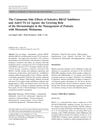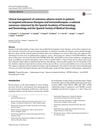Cutaneous Adverse Effects of BRAF Inhibitors in Metastatic Malignant Melanoma: A Prospective Study in 20 Patients
March 2014
in “
Journal of the European Academy of Dermatology and Venereology
”
BRAF inhibitors vemurafenib dabrafenib alopecia cutaneous side effects verrucous papillomas keratoacanthomas squamous cell carcinomas hyperkeratotic eruptions facial erythema seborrhoeic dermatitis-like eczema cystic lesions hand–foot skin reactions hyperkeratosis phototoxic reactions skin side effects skin reactions hair loss
TLDR BRAF inhibitors for melanoma often cause skin side effects, but they can be managed with proper care.
The study prospectively examined the cutaneous side effects of BRAF inhibitors in 20 patients with metastatic malignant melanoma. Over a treatment period of 2–52 weeks, 58% of patients on vemurafenib developed cutaneous side effects, with 42% experiencing more than one adverse event. Common reactions included verrucous papillomas (42%), hyperkeratotic folliculocentric eruptions (37%), and phototoxic reactions (26%). Less frequent effects were keratoacanthomas, squamous cell carcinomas, facial erythema, seborrhoeic dermatitis-like eczema, cystic lesions, hand–foot skin reactions, hyperkeratosis of the nipples, and alopecia. One patient on dabrafenib experienced multiple skin issues, including curly hair and keratotic papules. The study concluded that while multiple cutaneous toxicities were common, they were generally well controlled with appropriate treatment. Regular dermatological assessments were recommended to manage these side effects effectively and prevent the premature discontinuation of the therapy.





